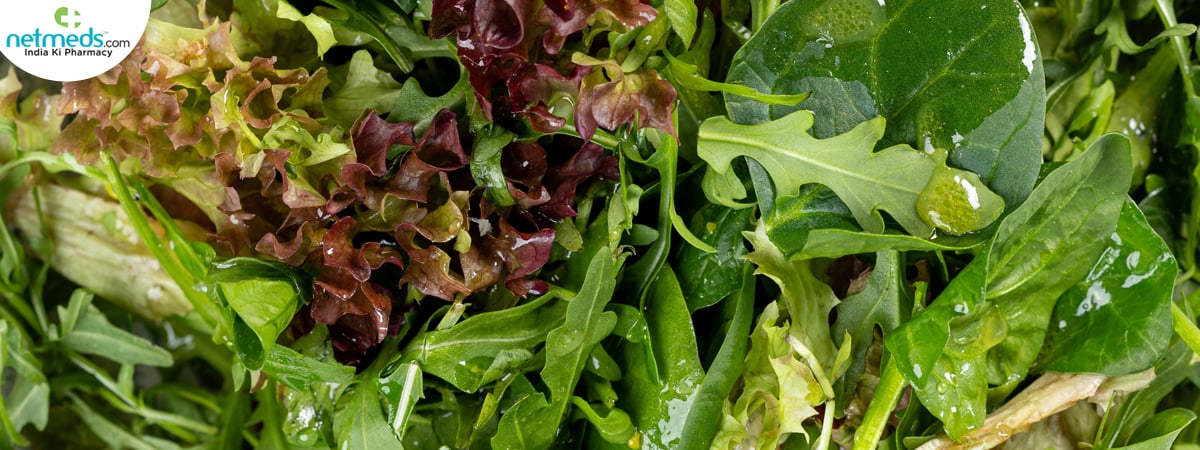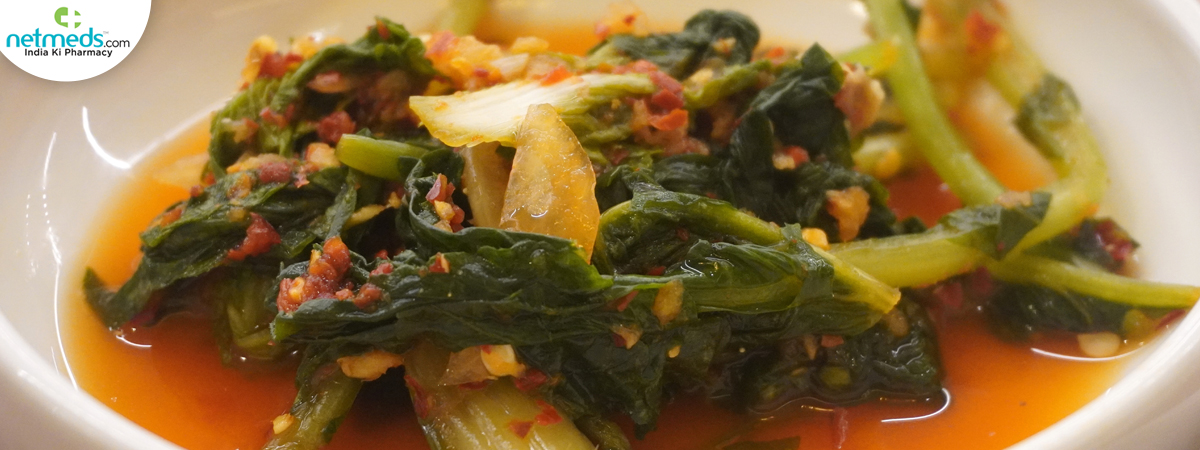Winter brings leafy greens back into our lives, thus offering a fresh burst of colour and the warmth needed during these colder months. From soups and stews to vibrant salads and stir-fries, there are countless delicious ways to enjoy winter greens. For centuries, people in the Himalayan regions of Nepal, Bhutan, Tibet, and Northern India have used fermented foods to stay healthy and nourished. One of their most treasured traditions is fermenting leafy greens. This process preserves fresh harvests during long winters and enhances their nutritional value. Interestingly, today, modern research confirms what these ancient cultures knew. Fermented leafy greens are indeed a tasty, natural, and easily available source of probiotics that support gut health, digestion, and overall wellness. This article delves into why fermenting your greens is great, the health benefits, and an easy fermented green recipe you can try this season.
Also Read: Bathua/ Bathua Saag: Nutrition and Health Benefits Of This Green Leafy Vegetable

Why Ferment Leafy Greens?
Digestive disorders, weakened immunity, and chronic inflammation are increasingly common these days; thus, turning to simple, traditional fermentation techniques may be one of the most effective ways to restore balance in the body. Not just a method of food preservation, fermentation is, in fact, a biological transformation. When leafy greens are submerged in a salt brine, naturally occurring lactic acid bacteria break down sugars and fibres, creating a tangy, nutrient-dense probiotic food.
Also Read: Low On Immunity? Enhance Your Inner Strength This Winter With Ayurvedic Wisdom
Key Benefits Of Fermented Leafy Greens
Better Digestion
Lacto-fermentation produces beneficial bacteria that help maintain a healthy gut microbiome. These microbes support digestion, nutrient absorption, and even mental health via the gut-brain axis.
Enhanced Nutrient Availability
Fermentation breaks down anti-nutrients like oxalates and phytates, making essential minerals such as iron, calcium, and magnesium more bioavailable. This enhances the nutritional value of a product.
Boosted Immunity
Nearly seventy percent of the immune system is balanced through the gut. A healthier microbiome helps strengthen immune responses and reduce inflammation.
Long-Lasting Preservation
Fermented greens can stay fresh for months without refrigeration, making them a convenient nutrient source year-round.
Improved Digestibility
The fermentation process partially pre-digests fibrous greens, reducing bloating and supporting smoother digestion. Better gut health amounts to better overall well-being.
For Optimal Health And Well-Being, Shop From Our Best-Selling Nutritional Supplements
5 Leafy Greens That Ferment Exceptionally Well
While many leafy greens can be fermented, the following five varieties provide outstanding flavour, texture, and health benefits:
Spinach
Spinach is a nutrient powerhouse packed with iron, folate, and antioxidants. When fermented, its oxalate content decreases, making nutrients easier to absorb. Fermented spinach develops a mild, tangy flavour that pairs well with rice bowls, soups, and sandwiches.
Kale
Kale becomes softer and significantly less bitter when fermented. Rich in vitamins A, C, and K, fermented kale supports detoxification and immune function. It is excellent when added to salads, soups, or eaten straight from the jar.
Mustard Greens
Mustard greens have been traditionally fermented in Himalayan households to make Gundruk, a local mountain delicacy. Fermented mustard greens have a pleasantly sharp and earthy flavour that boosts digestive health and supports metabolism.
Swiss Chard
Swiss chard’s thick leaves hold up well in brine. Fermentation enhances its magnesium, potassium, and antioxidant profile. Its mild, slightly salty flavour makes it a versatile addition to wraps, salads, and grain bowls.
Bok Choy
Common in Asian fermentation traditions, Bok choy ferments quickly and evenly. It becomes tender, flavourful, and probiotic-rich, great for broths, noodles, and stir-fries.
Also Read: Sapodilla /Sapota: Health Benefits, Nutrition, Uses, Recipes, And Side Effects
How To Ferment Leafy Greens?
Not very complicated, leafy greens are a part of our regular diet, and we cook them in several ways. This time, try this simple Himalayan-inspired recipe by the traditional preparation of Gundruk and similar Himalayan ferments. You can use one type of green or mix several.
Ingredients
· 4 cups leafy greens such as spinach, mustard greens, kale, chard, or Bok choy
· 2 teaspoons sea salt
· 4-5 garlic cloves
· ½ teaspoon chili flakes (Optional)
Method:
· Rinse the greens thoroughly to remove dirt. Pat them dry. A little moisture is fine, but avoid soaking wet leaves
· Slice the leaves into medium-sized pieces
· Place the chopped greens in a large bowl and sprinkle salt over them. Massage the greens for five minutes until they soften and release liquid. This liquid becomes the brine.
· Tightly pack the greens into the jar. Press down firmly with your fist or spoon until the brine rises above the leaves. They must always stay submerged.
· Slide garlic cloves or chili flakes between the layers for extra flavour.
· Seal the jar loosely and leave it at room temperature for fermentation for about five days
· Check daily to ensure the greens remain submerged. Press them down if needed.
· Once fermented to your liking, seal the jar tightly and refrigerate. The flavour continues to develop slowly and can last three to four months.
Also Read: Sweet Bamboo Shoots: Health Benefits, Uses Of This Exotic Bamboo Variety. Easy Recipe
How To Enjoy Fermented Leafy Greens?
· Add a spoonful to rice or millet bowls
· Mix into salads for extra tang
· Add to soups near the end of cooking
· Blend into dips or spreads
· Eat straight from the jar for a probiotic boost
Fermented leafy greens are a way to nourish the body from the inside out. Whether you are interested in improving your gut health or exploring global food traditions, fermenting your greens is a great way to support long-term wellness. If you are new to fermentation, start with a small batch.
Here is a traditional Himalayan mountain recipe made from fermented greens, inspired by Nepalese, Kumaoni, and Tibetan food heritage. Gundruk ko Jhol (Fermented Leafy Greens Soup) is a warming, probiotic-rich, lightly spiced soup enjoyed in mountain homes for centuries.

Gundruk ko Jhol (Traditional Fermented Greens Broth)
Ingredients
· 2 cups fermented leafy greens
· 8 cups water (or vegetable broth for richer flavour)
· 2 small, chopped tomatoes
· 1 medium-sized sliced onion
· 2 green chilies (optional)
· 1 medium cubed potato
For Tempering
· 2 tbsp mustard oil or ghee
· ½ tsp turmeric
· 1 tsp cumin seeds
· 1 tsp fenugreek seeds
· 5 sliced garlic cloves
· Salt to taste
· Fresh coriander for garnish
Method
· Rinse the greens and keep aside
· In a pot, heat a teaspoon of oil
· Add onions and sauté until translucent
· Add tomatoes and chilies, cooking until soft
· Add potatoes and cook for about five minutes
· Add the fermented greens
· Pour in water or broth and let it simmer
· The broth becomes lightly sour and aromatic
Prepare the Tempering
· In a small pan, heat mustard oil or ghee
· Add fenugreek and cumin seeds
· Add garlic slices and fry until golden
· Add turmeric and immediately pour this sizzling mixture into the soup.
· This tempering infuses warmth
· Simmer for 2 more minutes
· Garnish with fresh coriander and serve hot
Ideal for cold mountain evenings, this tangy broth is rich in probiotics, minerals and offers a deep fermented flavour. It can be enjoyed as a starter or with bread. Besides preserving the traditional flavours, it is warming and incredibly nourishing.
(This content is reviewed by Kalyani Krishna, Chief Content Editor)
Author Profile: Preeti Sharma
Preeti Sharma has a master’s in electronic media and mass communication and certification in short-term writing from Florida. With close to a decade of experience, she specializes in crafting engaging blogs on beauty, veterinary care, and healthy cooking. Preeti is proficient in video editing tools and produces captivating and informative content across multiple platforms.
References:
Fermented Vegetables: Health Benefits, Defects, and Current Technological Solutions
Xiqian Tan, Fangchao Cui
https://pmc.ncbi.nlm.nih.gov/articles/PMC10777956/
https://www.sciencedirect.com/science/article/pii/S0740002025000139



 Previous
Previous